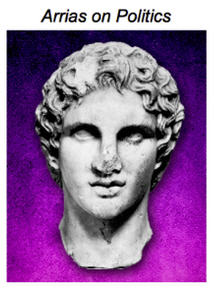Arrias: Marx for Treasurer
 On Friday Secretary of the Treasury Yellen said that inflation could climb as high as 3% by the end of the year. But she added that she “believe(s) this represents transitory factors.” In this she echoes Federal Reserve Chairman Powell, who has been saying for several months that signs of inflation are “transitory.”
On Friday Secretary of the Treasury Yellen said that inflation could climb as high as 3% by the end of the year. But she added that she “believe(s) this represents transitory factors.” In this she echoes Federal Reserve Chairman Powell, who has been saying for several months that signs of inflation are “transitory.”
But, what exactly is inflation? Inflation is not a rise in prices of various goods and services. A rise in prices may occur as result of inflation (and usually does). But the price increase follows the inflation. Inflation is the expansion of the money supply. Economists will be more pedantic and insist that inflation is “more dollars chasing fewer goods” or a change in the ratio between the currency and the goods and services in the Economy in favor of the currency. Thus, technically, if the economy shrinks, if the same number of dollars are in circulation, you would have inflation.
But that is not what is happening; what is happening in the US (and elsewhere, everyone else is doing it too) is this: dollars are being printed.
.
How many? Well, there’s the tale. Unfortunately, this requires looking at some numbers; please bear with me.
The common measure of the dollar is something called the Monetary base.
In August 2008, before the economic bust of October, 2008, the “Monetary Base” – the total number of dollars in circulation plus dollars held in ready reserve at central banks – totaled $847 billion. By January of 2009 it was $1,712 Billion. The Fed continued to print money (with the exception of two plateaus) and by August 2014, the Monetary Base had reached $4,049 billion. The base then began to drop and by January 2017 had reached $3,595 billion. A slight rise followed then it again continued to drop and by October 2019 was at $3,253 billion. And then it began to climb, gradually at first but then at an amazing rate. The full numbers below tell an interesting tale, in particular when compared to numbers over the past 60 years.
Note what happened to the ratio of the size of the economy (GDP) and the amount money in circulation (the Monetary Base). Traditionally, it was held that the ratio should be in the neighborhood of 15 to 1.
Year Monetary GDP GDP/Monetary Base
Base (In Billions)
(in Billions)
1960 $ 51 $ 540 10.65
1970 $ 76 $ 1,090 14.26
1980 $ 156 $ 2,990 19.2
1990 $ 315 $ 6,000 19.0
2000 $ 602 $10,440 17.3
2008 $ 847 $14,560 17.2
2009 $1712 $14,630 13.7
2014 $4049 $17,850 4.4
2017 $3595 $19,920 5.5
2019 $3523 $21,730 6.7
2020 $5149 $21,480 4.2
2021 $6042 $22,675 (est) 3.75
Modern Monetary Theory (MMT), the “hot,” “new,” preferred monetary theory, posits that the major fulcrum around which inflation moves is employment; once the economy reaches “full employment” (a condition defined by the government), inflation is a risk, but it can be controlled by taxation, which reduces the amount of money in the private sector that might otherwise be used to drive up labor costs and spur inflation.
Per MMT, the government printing money will not cause inflation, rather moving past “full employment,” causes inflation and the government knows how to control that.
And so, the government need not worry about printing too much money, and is therefore free to do so.
This really isn’t new. Jeff Diest, writing for the Mises Institute, points out that kings have been doing this sort of thing for millennia. Further, as he points out, this isn’t monetary policy, it’s a tax and state financing scheme, and it is based not on economics but on accounting sleight of hand.
But, money isn’t wealth, money represents wealth. A car rolling off a production line, grain harvested from a field, etc., these things are real wealth. Pieces of paper with numbers on them are not.
Further, this deluge of spending, despite what the Secretary says, despite what the Federal Reserve Chairman says, has already moved prices higher. The Consumer Price Index, the common figure cited as representative of inflation, has been carefully manipulated over the years to give misleading numbers.
One simple example is that the median price for existing homes is up 17% in the last year. Basic grain prices are also soaring, energy prices are up (oil is now over $60 per barrel, gasoline is up 49% since April of 2020), and anyone who has tried to buy wood will tell you that the prices of materials for construction are substantially higher.
The Biden Administration has a plan that will increase the national debt to more than $30 trillion over the next decade, and includes printing of a good deal more money.
But the MMT acolytes tell us not to worry, they’ve got in under control; they’ll just tax us more the economy starts heating up. And keep issuing more notes…
As Marx said: “Don’t be scared. You’ll get it back. I’ll give you my personal note for ninety days. If it isn’t paid by then, you can keep the note.”
Of course, that was Groucho, the smart Marx. At least he knew he was picking someone’s pocket.
Copyright 2021 Arrias
www.vicsocotra.com
